Graphing in Physics (DP IB Physics): Revision Note
Constructing graphs
Sketch graphs
Sketch graphs are a way to describe the qualitative trend between variables
Axes must be labelled, but they do not need to include scales or data points
The shape of the graph depends on the relationship between the variables, such as
linear
non-linear
directly proportional
inversely proportional
Sketch graphs of Boyle's law

For the graphs of pressure
and volume
above:
against
is a linear (straight line) graph through the origin, indicating
is proportional to
against
is a non-linear (curved) graph, indicating
is inversely proportional to
against
is a straight, horizontal line, indicating
is constant as
increases
Linear graphs
A straight line graph represents a linear relationship
This indicates the rate of change between two variables is constant
If two variables,
and
, are directly proportional
the graph of
against
is a straight line passing through the origin
the calculated values of
are constant
All directly proportional graphs are linear, however, not all linear graphs are directly proportional
Non-linear graphs
A curved graph represents a non-linear relationship
This indicates the rate of change between two variables is not constant
If two variables,
and
, are inversely proportional:
the graph of
against
is a shallow curve which does not cross either axis
the graph of
against
is a straight line passing through the origin
the calculated values of
are constant
Presenting and interpreting data
Students are expected to be able to present and interpret raw and processed data in tables, charts, and graphs
Bar charts
Shows qualitative or discrete data as columns on a graph
Each column represents a qualitative variable
The height of the column indicates the size of the group
Pie charts
Shows proportions of qualitative or discrete data as slices on a circle
Each slice represents a qualitative variable
The size of each slice indicates the relative proportion of the variable
Histograms
Shows quantitative or continuous data as columns on a graph, but without spaces between adjacent columns
Each column represents a quantitative variable
The height of the column indicates the size of the group
Scatter graphs
Shows the correlation between continuous variables
Data points are plotted, and then a line of best fit is drawn
Example: A graph showing how the force applied to a spring affects its extension
Line/curve graphs
Shows functional relationships between variables
Data points are plotted and then connected in sequence by line
Example: A graph showing the distance travelled by a car over a certain period of time
Plotting graphs
When plotting a graph, remember the following:
Label axes, and include units
The independent variable should go on the x-axis and the dependent variable should go on the y-axis
Use appropriate linear scales
Ensure that all data points are plotted within the graph area
The plotted points must occupy at least half or more of the sheet or grid
A rough rule of thumb is that if you can double the scale and still fit all the points on, then your scale is not appropriate
Plot data points accurately
The most common convention is to use small crosses to show the data points
Graph of distance versus time
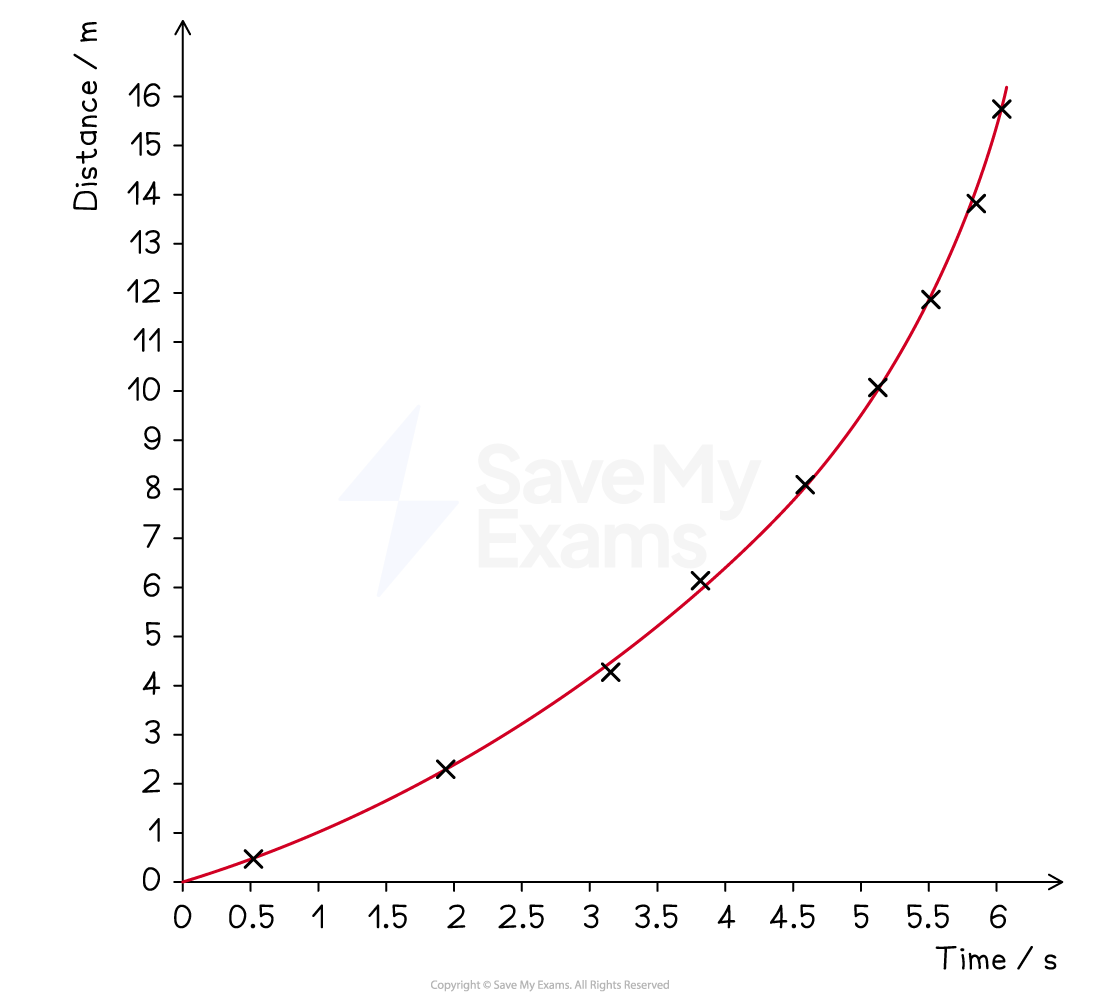
Remember: The independent variable is the one you control or manipulate and the dependent variable is the one that changes as a result of your manipulation
Always draw data points in pencil as it makes it easier to make corrections and adjustments
Lines of best fit
Students often confuse the term lines of best fit with straight lines
A line of best fit may be straight or curved, depending on the trend shown by the data
If the line of best fit is straight, make sure it is drawn with a ruler
If the line of best fit is a curve, make sure it is drawn smoothly
A line of best fit should
have a balance of data points on either side of the line
be drawn through the origin (but only if the data and trend allow it)
How to draw a best-fit line
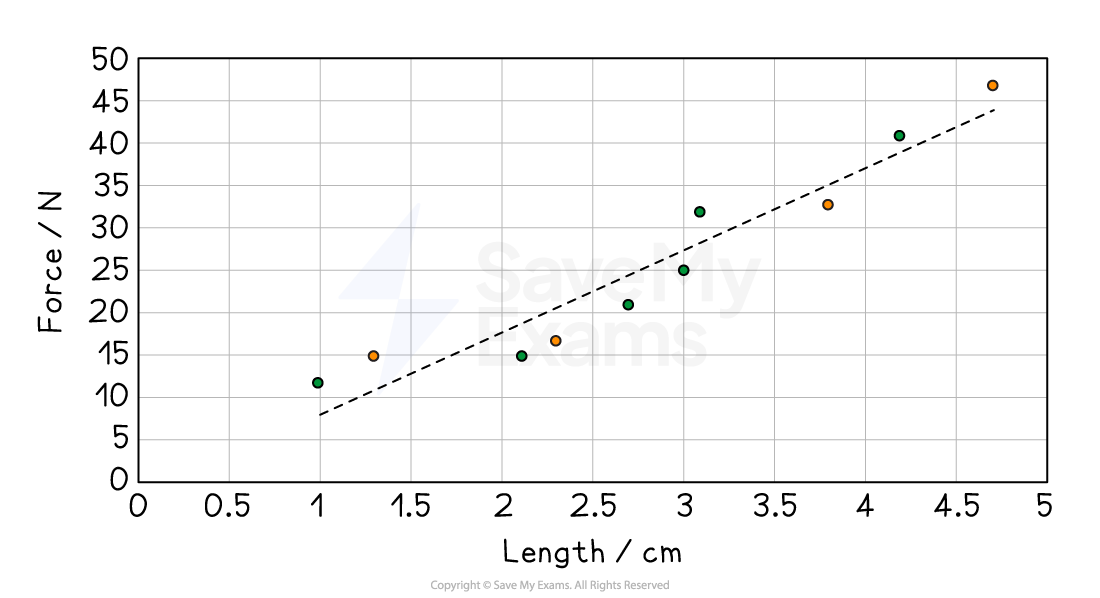
Interpreting graphs
Gradient
On a linear (straight line) graph, the gradient is constant
On a graph of
against
the gradient is equal to
Where
= change in
, or
= change in
, or
To find the gradient of a straight line
draw a large triangle
The triangle should be as large as possible to minimise precision errors
read off the values from the axes
When reading off values, you can utilise points that lie on the line of best fit, but not data points that lie away from the line
calculate the gradient using the above equation
The units of the gradient will be the ratio of the y variable unit and the x variable unit
e.g. for a graph of extension x (in m) against force F (in N) the units of the gradient would be N m-1
Worked Example
Calculate the gradient of the following graph.

Answer:
Step 1: Draw a large gradient triangle

Step 2: Use the gradient equation
Gradient = = = 15.7 Ω m-1
Changes in gradient
The gradient of a curved line is constantly changing
To find the gradient of a point on a curve
Draw a tangent to the graph, using a ruler to line up against the curve at the point where the gradient is to be measured
Then, use the equation for a straight line to calculate the gradient
How to draw a tangent to a curve

Intercepts
The equation for a straight line is y = mx + c, where:
y = dependent variable
x = independent variable
m = slope
c = y-intercept
The y-intercept is the y value obtained where the line crosses the y-axis when x = 0
Equation of a straight line

Maxima and minima
The maxima and minima are the highest and lowest points respectively
Maxima - the gradient goes from positive to 0 to negative
Minima - the gradient goes from negative to 0 to positive
Areas under the graph
The area under a graph often represents a physical quantity
e.g. the area under a velocity-time graph represents displacement
When the area is a rectangle or a triangle, it is easy to find by calculating
area of rectangle = base × height
area of a triangle = ½ × base × height
How to find the area under a straight line
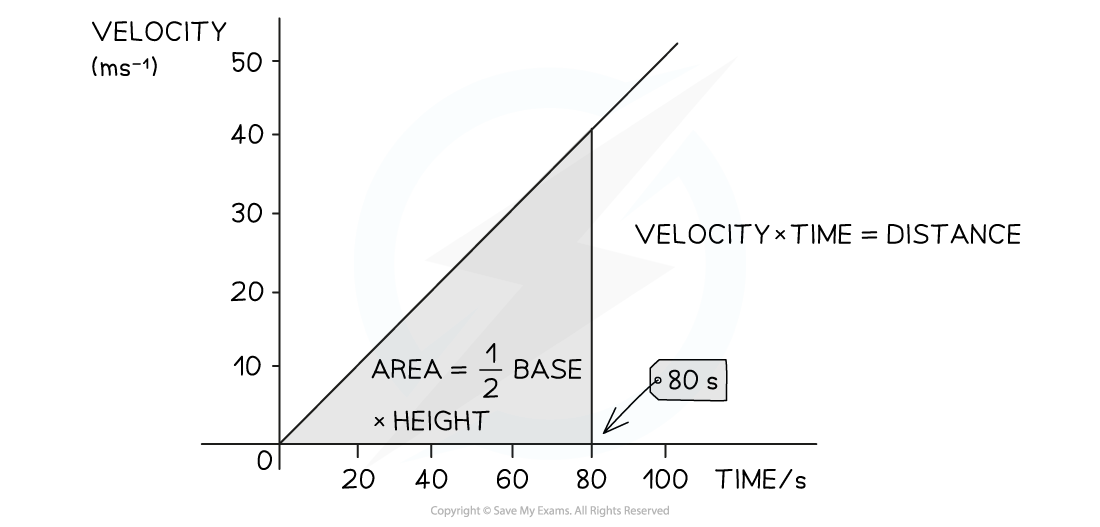
When the line is curved, area is found though the following steps
Divide the shape into rectangles and triangles as shown
Find the area for each by calculating
Count the remaining squares
Add the totals together
How to find the area under a curved line
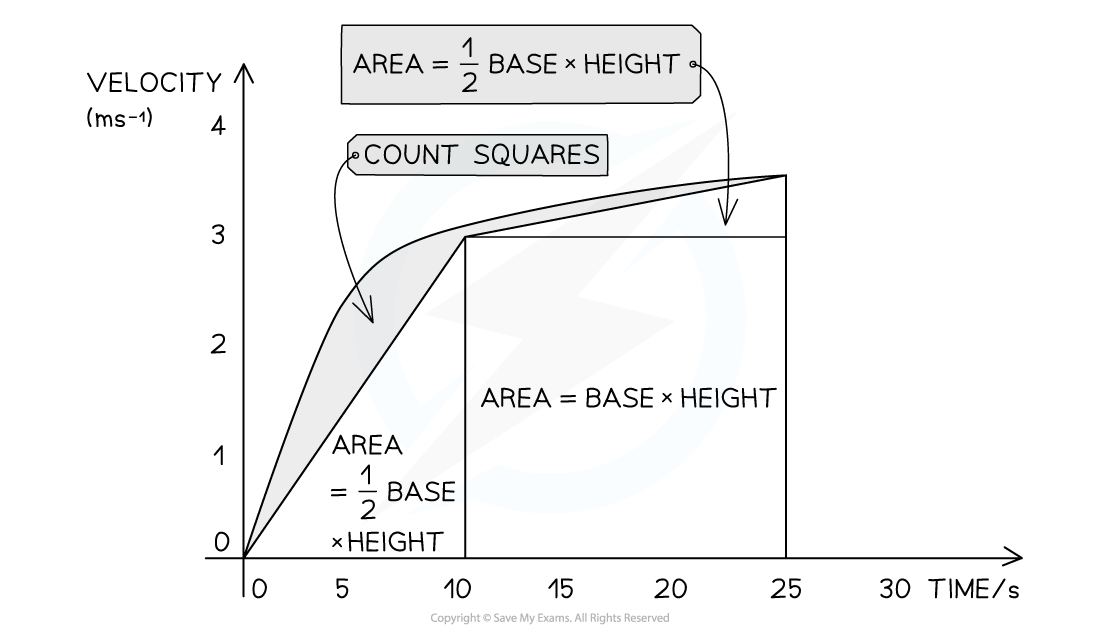
Extrapolating and interpolating graphs
Extrapolation is extending a line of best fit to estimate values that lie beyond the data points of a graph
Interpolation is using a line of best fit to estimate values that lie between data points of a graph
Extrapolation and interpolation on a graph
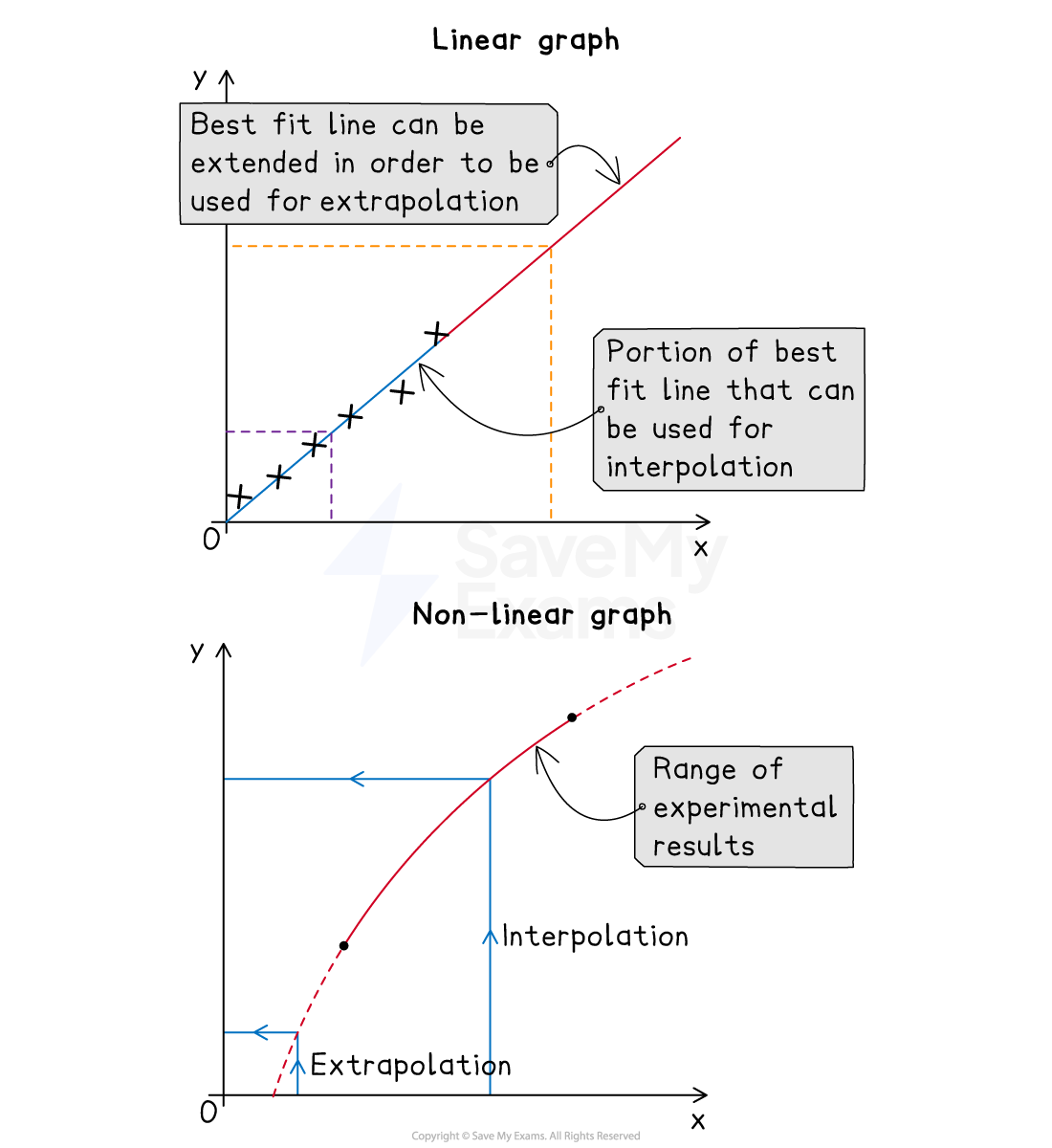
Linearising graphs
Linear (straight line) graphs are easier to interpret than non-linear graphs
Linearising a graph involves rearranging the variables in a non-linear relationship to fit the equation of a straight line y = mx + c
e.g. the time period of a pendulum is
Squaring both sides gives
Therefore, for a graph of
against
, gradient =
Common linearised relationships

Logarithmic graphs
What are logarithmic scales?
Logarithmic scales are scales where intervals increase exponentially
A normal scale might go 1, 2, 3, 4, ...
A logarithmic scale might go 101, 102, 103, 104, ...
Sometimes we can keep the scales with constant intervals by changing the variables
If the values of x increase exponentially: 101, 102, 103, 104, ...
Then you can use the variable log x instead which will have the scale: 1, 2, 3, 4, ...
This will change the shape of the graph
If the graph transforms into a straight line, then it is easier to analyse
The numbers in a logarithmic scale represent logarithms, or powers, of a base number (usually 10 or e)
Why do we use logarithmic scales?
Logarithmic scales are useful when analysing quantities which vary over several orders of magnitude
When variables have a large range, it can be difficult to plot them on one graph
Especially when a lot of the values are clustered in one region
If we are interested in the rate of growth or decay of a variable, rather than the actual values, then a logarithmic scale is useful
Constructing logarithmic graphs
Semi-log graphs
A semi-log graph is used when only one scale (the y-axis) of the original graph is logarithmic
Graphs of exponential functions appear as straight lines on semi-log graphs
If
Takes logs of both sides
Split the right-hand side into two terms
Bring down the power
This is of the form
, where
is on the
-axis and
is on the
-axis
the gradient is
and the y-intercept is
Log-log graphs
A log-log graph is used when both scales of the original graph are logarithmic
Graphs of power functions appear as straight lines on log-log graphs
If
Takes logs of both sides
Split the right-hand side into two terms
Bring down the power
This is of the form
, where
is on the
-axis and
is on the
-axis
the gradient is
and the y-intercept is
For example, consider Kepler's law:
The relationship between T and r can be shown using a log-log graph
The graph of log T in years against log r in AU (astronomical units) for the planets in our solar system is a straight-line graph
Kepler's law as a log-log graph
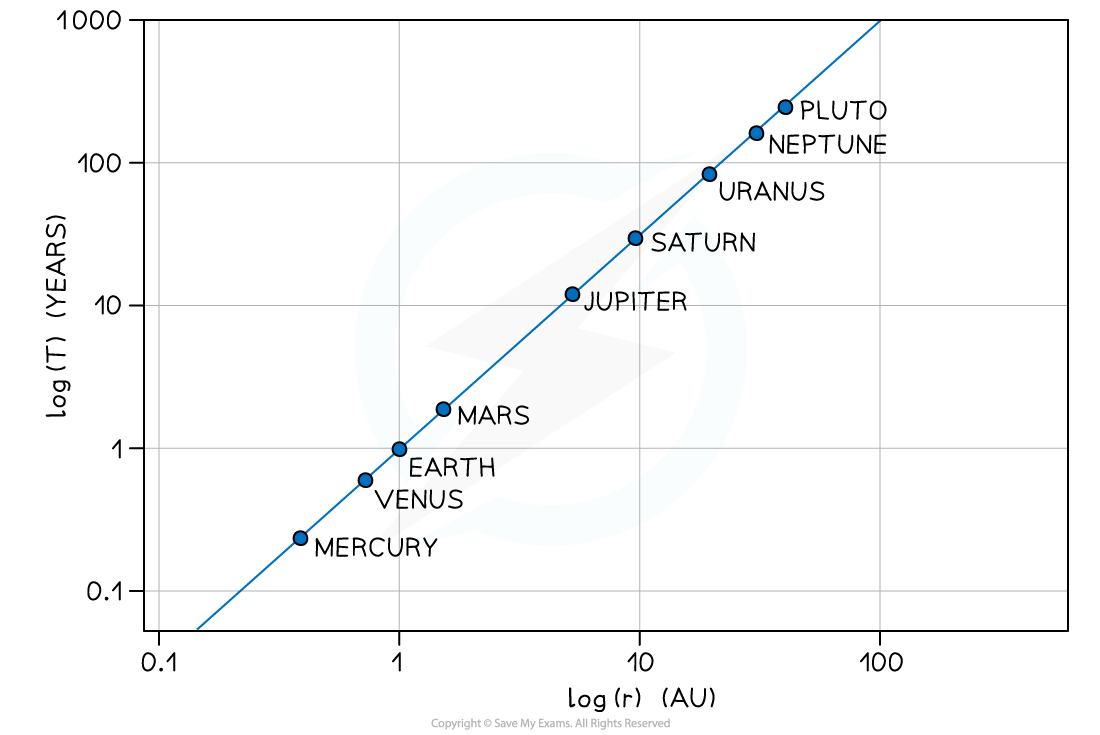
The logarithmic graph of log T against log r gives a straight line
The graph does not go through the origin since it has a negative y-intercept
Only the graph of log T and log r will produce a straight-line graph, a graph of T vs r would not
Examiner Tips and Tricks
Pay close attention to which base is being used (log or ln). In the above examples, logarithms to the base 10 have been used, but natural logarithms (ln) are often used in topics such as radioactive decay.
When reading a value off a logarithmic scale:

Unlock more, it's free!
Did this page help you?